
About
Shortleaf pine forests and associated habitats once covered a vast area of the continent – from eastern Oklahoma and Texas, to the Atlantic Coast from New Jersey down to Florida – and helped fuel industrial expansion into the region. Early settlers and Government Land Office surveys describe many of these pine- dominated and mixed pine-oak forests as open woodlands where enough sunlight reached the ground to support a diverse assortment of native wildlife species.
These resilient and adaptive forests, spanning parts of twenty-two states, represent an extraordinary diversity of cultural, ecological, and economic values, yet are being displaced. With millions of people depending upon the benefits this under-appreciated species provides, including wildlife and recreation, water quality and high-value wood products, the need to conserve and better manage the shortleaf pine ecosystem is more compelling than ever.
Conservation
Shortleaf pine is the most widespread pine species in the southeastern United States. Its natural range includes 21 states, extending from New York, south to north Florida and west into Texas and the eastern quarter of Oklahoma. Shortleaf-dominated landscapes support a wide variety of native grasses, wildflowers, forbs and wildlife species; survive on the harshest of sites; and are adapted to frequent wildfire and drought.
Habitat loss for the species is a concern and is the result of several factors, including changes in fire frequency, large-scale tree plantings of faster-growing loblolly pine which have displaced native shortleaf on many sites and an increase in shortleaf X loblolly hybrids that is jeopardizing shortleaf’s genetic integrity.
Learn more about shortleaf pine conservation at the Oklahoma Forestry Services.
Photographers
All photographers generously donated their work for this project
Funding
Funding for this poster was provided by:
Oklahoma Biological Survey, Oklahoma Forestry Services, U.S. Forest Service, Oklahoma Natural Areas Registry, and University of Oklahoma
The Biodiversity of Oklahoma poster series is a project of the Oklahoma Biological Survey and the University of Oklahoma.
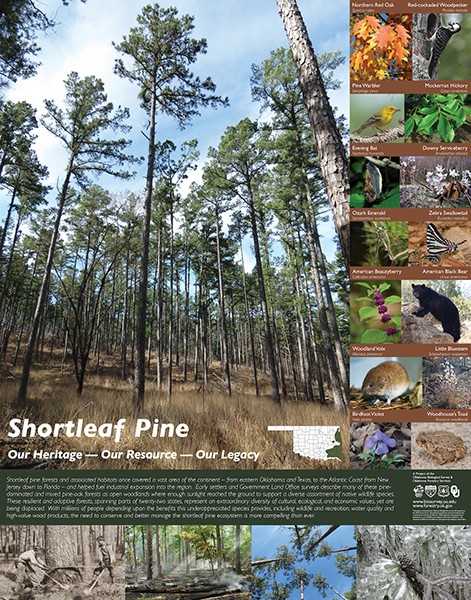
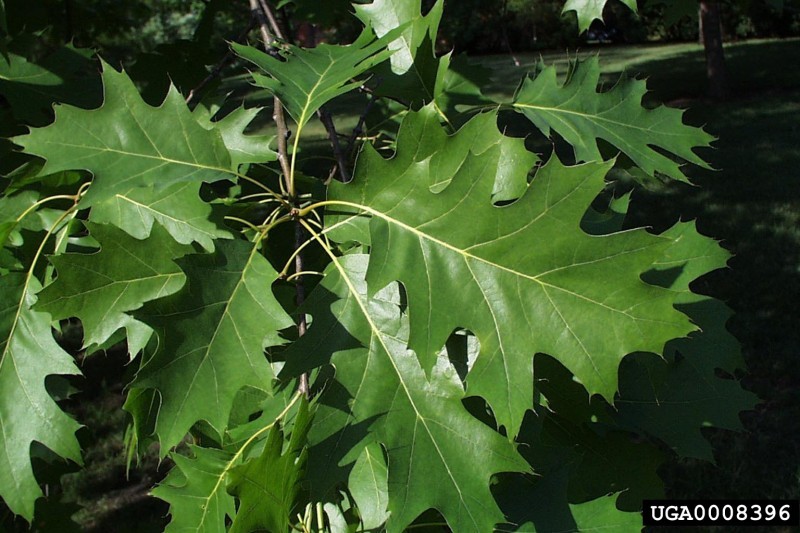
Northern Red Oak (Quercus rubra)
The northern red oak is a tree species native to southeastern Canada and the eastern United States, stretching as far west as eastern Nebraska and Oklahoma and as far south as Georgia and Alabama. It features dense foliage, providing lots of shade, and has a rounded shape. This oak species usually grows between 65 and 100 feet tall, but in rare cases can be over 150 feet tall. It grows very quickly, sometimes more than two feet per year for a period of about ten years. Often this tree species grows in pure stands of northern red oaks, but it also grows in mixed stands with other trees (like pines!) where it is usually predominant. It is most successful in deep, moist, well-drained soil but can tolerate a variety of soil types. It has alternating leaves, usually between 4 and 8 inches long, which turn a beautiful red color in the fall. Its symmetrical, round shape and fall foliage colors are favored by people and make it a good ornamental tree.
In addition to its aesthetic value, the northern red oak is an important source of lumber as well as an important food source for many animals. These trees begin producing fruit (acorns) after about 25 years, but the acorns are not produced abundantly until the tree reaches about 50 years old. Blue jays, squirrels, raccoons, turkeys, small rodents, whitetail deer, and black bears all love eating this tree’s acorns, making it even more important to protect the forest stands where northern red oaks are found.
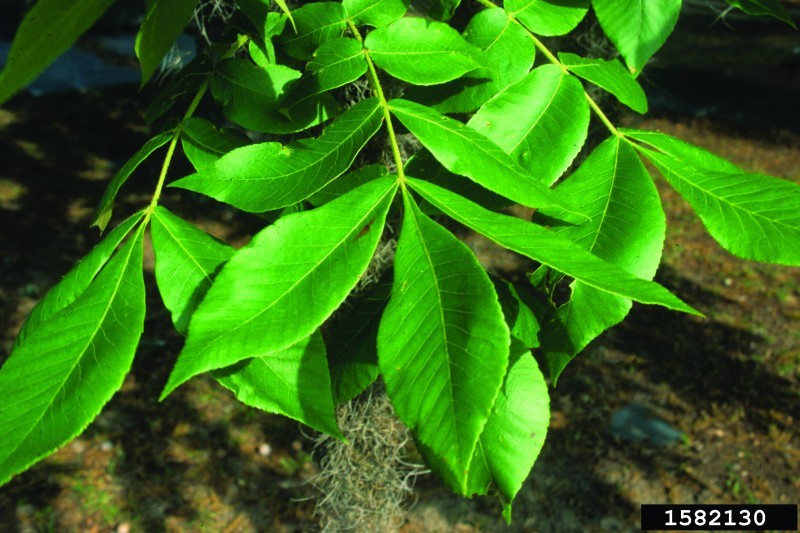
Mockernut Hickory (Carya tomentosa)
The Mockernut Hickory is a medium-to-large sized tree in the walnut tree family. It is a native to the eastern half of the United States with its range spanning from Massachusetts south to Florida and as far west as Kansas and Oklahoma, often preferring humid climates. It has broad, flat, alternating compound leaves that grow about 9 to 14 inches long. The underside of the leaves is covered with short dense hairs, called “Tomentum” in Latin in and where the species name comes from. It typically grows 65 to 100 feet tall and has a very long life-span, living up to 500 years! This tree grows long, slender, and straight and has no branches on the bottom half of the trunk. In order to grow so tall and live for so long, withstanding all kinds of weather and supporting its own weight, it must be a pretty sturdy tree. Its light-colored wood is very hard, strong, and tough, which makes it a good source of wood for human use. In fact, of the mockernut hickory that is harvested by humans, almost 80% of it is used to manufacture tool handles. That’s a lot!
This tree is also important to many different animal species, both for food and for a place to live. Mockernut hickory trees produce large fruit, which is ellipsoidal in shape, about two inches long and has very thick shells that split open to expose small kernels of “meat” (the nuts) inside. These nuts and sometimes even the bark are eaten by black bears, foxes, and mice. Some birds which nest in cavities in trees also use this tree for nesting and raising their young. The mockernut hickory is the most abundant hickory species, so it’s pretty important to both people and animals, making the maintenance of their habitat, such as shortleaf pine forests, a priority.
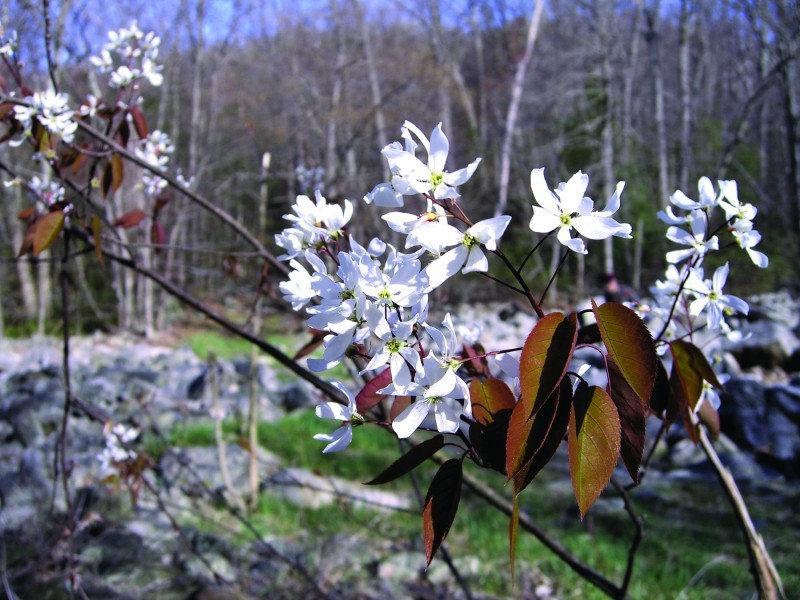
Downy Serviceberry (Amelanchier arborea)
The downy serviceberry is a deciduous perennial tree native to eastern North America and is widespread across its range, from Maine south to Florida and west to Iowa and Oklahoma. It is a common understory tree that prefers moist, well-drained soils in a variety of habitats, including dry woods, forest edges, open woodlands, swampy lowlands, fields, and along stream banks. This tree got its common name, serviceberry, because its beautiful white, fragrant flowers appear in the early spring, around the same time that many memorial services were traditionally held. These flowers have five petals and will bloom from April to May, just prior to the blooming of redbud trees. Serviceberries produce red-purple, berry-like fruit in the summer, from June through August. The fruit, which tastes similar to blueberries, is a favorite food of birds and mammals, and it is also eaten by people, who use it in pies and other pastries. Historically, Native Americans made tea from serviceberry trees to help with digestion. They also used the tree’s hard, straight, and extremely heavy wood to make arrow shafts.
The downy serviceberry is a short-lived tree, usually only growing to be about 15 to 30 feet tall and rarely living for more than 50 years. It can have either a single or multi-stemmed trunk with smooth gray bark. The simple, oblong leaves are alternate and resemble those of their close relative, the apple tree. As the leaves are produced in the spring they are covered with soft, woolly hairs—where the “downy” part of its name comes from—that will eventually disappear. In the fall the leaves change to beautiful colors and can be anywhere from yellow to orange to red. The fall foliage, spring flowers, and summer berries make this a nice ornamental tree.
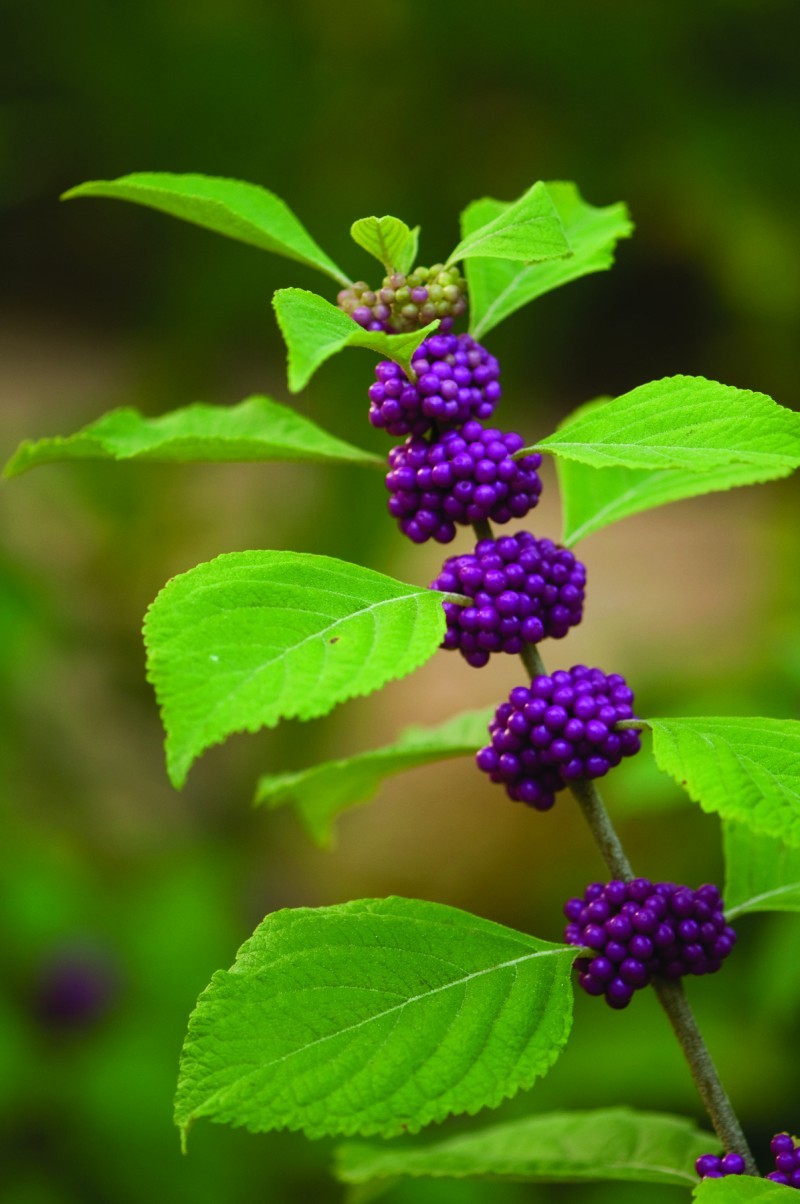
American Beautyberry (Callicarpa Americana)
The American beautyberry is a large, understory shrub in the Verbena family that is, unsurprisingly, native to the United States of America. This is a fast-growing perennial that prefers moist soil and can be found in woods and under open pine canopies, on the edges of swamps, on wet slopes, and in moist thickets. Dense canopies with a lot of mid-story vegetation and deep shade is bad for this species, so it is important to maintain open canopies with sufficient sunlight. It grows in the southeastern United States, northern Mexico, and even in the Caribbean. It usually grows about 3 to 6 feet tall and wide, and it features long, drooping branches with smooth, light brown or reddish brown bark. The American beautyberry blooms dense clusters of small, pink flowers from May through July, which are attractive for butterflies and birds. Its leaves usually grow in sets of twos or trees, are oval in shape, and can be up to 9 inches long. In the fall the leaves are a yellow-green color, a favorite of white-tailed deer. Its signature glossy purple fruit (and sometimes white) is berry-like and small, only about a quarter of an inch in diameter, and grows in clusters in the fall and winter. These beautiful berries are an important food source for many animals and birds, including squirrels, raccoons, foxes, opossums, armadillos, deer, and especially the northern bobwhite. All of the animals that eat these berries aid in seed dispersal, so the plants and the animals help each other.
The American beautyberry has been important for human uses, as well. Native Americans have traditionally used its roots, leaves, and berries to help treat different ailments, including fevers, rheumatism, malaria, dysentery, stomach aches, colic, and dizziness. Also, in the early 1900s it was common practice for farmers to crush the leaves of this shrub to repel mosquitoes. The compounds in the leaves that give them this repellant nature are callicarpenal and intermedeol.
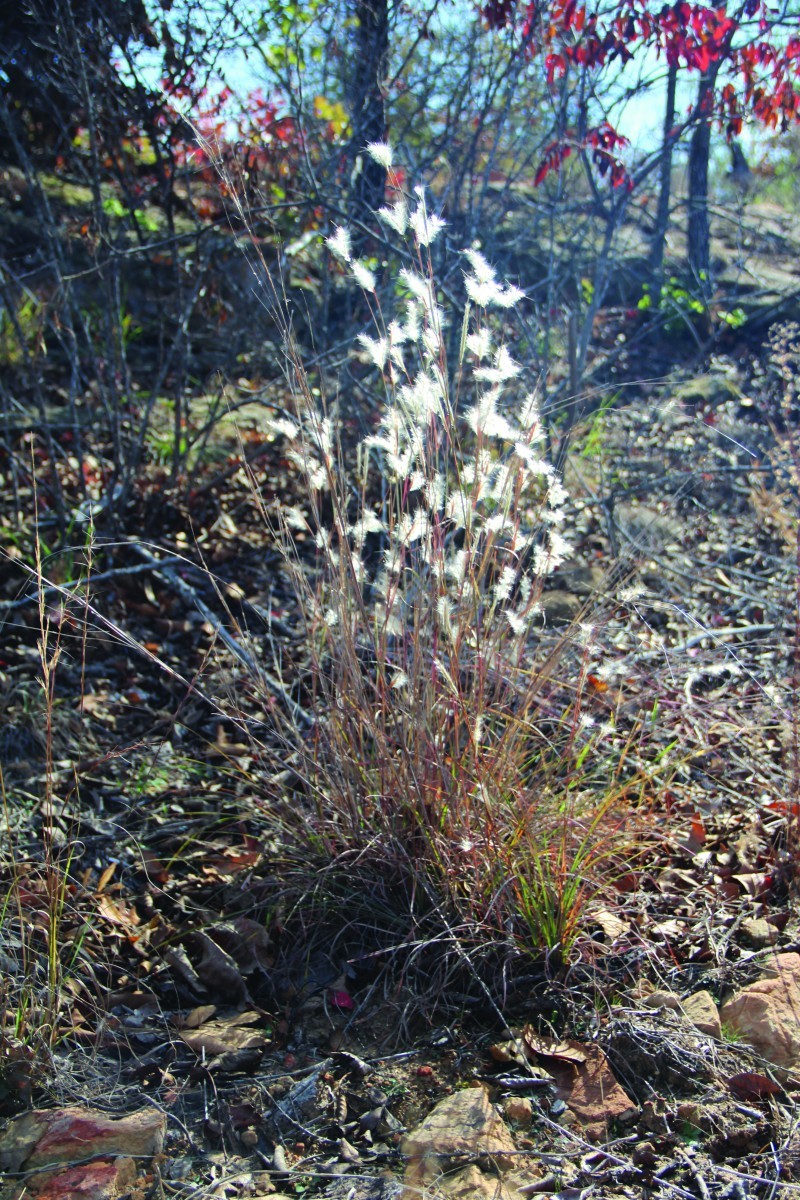
Little Bluestem (Schizachyrium scoparium)
A native, ornamental bunchgrass, little bluestem is widespread and can be found in Canada and everywhere in the United States except Nevada and Oregon. Because it has such a broad range it also has high genetic diversity and ecotypic variation. Its adaptations to live in a variety of habitats, tolerate drought, and appeal to wildlife has resulted in its use in many prairie restoration projects. It is very beneficial to many types of animals, as well. Little bluestem is a great grass for birds to nest and roost in, and it also provides food for cattle and horses. The plant’s seeds are eaten by birds and small mammals, and insects such as caterpillars, grasshoppers, and leafhoppers also use this plant as a food source. The fuzzy white seeds even provide food during the winter for different bird species.
Little bluestem gets its name from the plant’s slender, blue-green stems that begin growing in the spring and are more prominent in the late summer and early fall. It forms very dense mounds of grass and can grow one to three feet tall, with purple fruits. In autumn these plants become a radiant mahogany-red color and produce the white seed tufts that birds eat for food during the winter. It is a warm-season (C4) perennial grass that requires low water usage and dry soils. It grows on dry upland sites, in pine forests, and preferably on ridges, steep slopes, and hilltops.
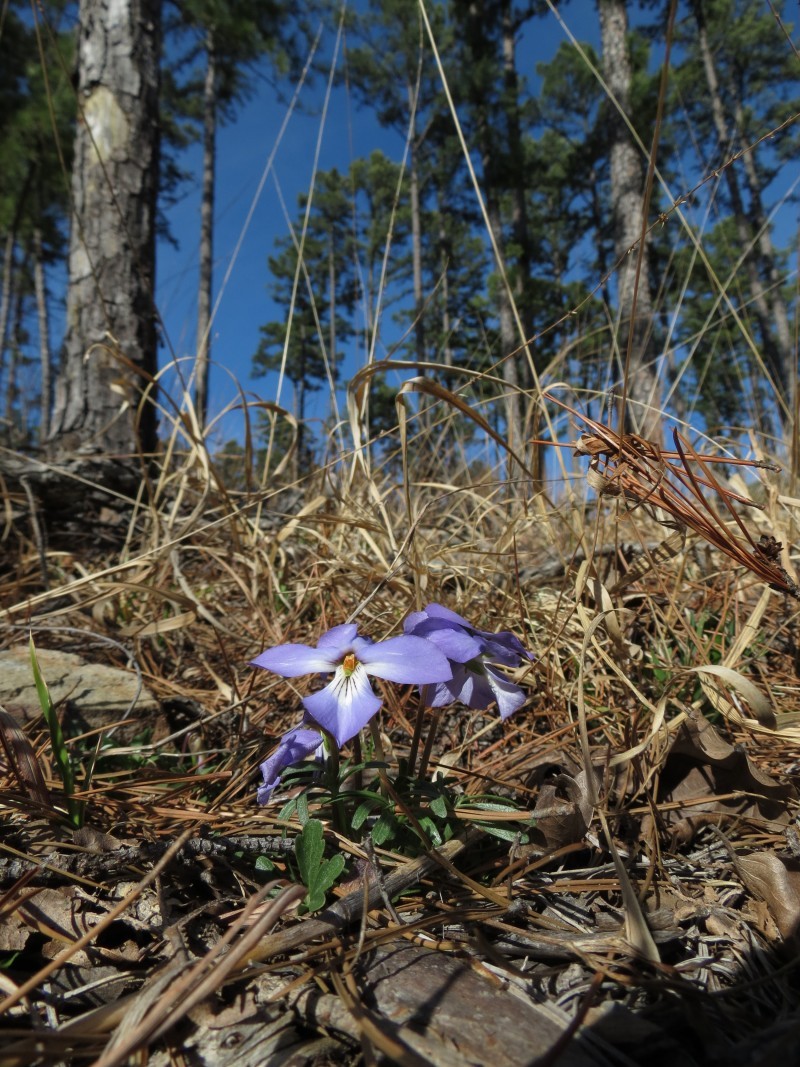
Birdfoot Violet (Viola pedata)
The birdfoot violet is a beautiful perennial that blooms from March to June and has (not surprisingly) blue-violet flowers that are fairly large, about the size of pansies. This is a low-growing, clumped plant that grows only 4 to 10 inches high. It gets its name from the shape of its leaves, which have three lobes that make it look like a bird’s foot. Each flower has five petals, of which the two upper petals are usually smaller and the lowest petal has streaks on it. There are two types of birdfoot violets: one has flowers that are totally pale violet in color, and the other has deep violet upper petals and three lower, light violet petals. However, some violets may even have white blooms, but these aren’t as common. Each flower has five stamens with bright orange anthers that produce pollen, and bees and butterflies are frequent pollinators of these attractive plants. This violet produces little fruits that birds eat, which helps to disperse its seeds, but the seeds are also disperse by ants which are attracted to the sugary gel on the seed’s surface.
The birdfoot violet is found in the eastern half of the United States, extending as far west as Texas and Oklahoma. It prefers dry, upland sites, and its native habitat is rocky, open woods, pinelands with dry soil, and sandy prairies. The birdfoot violet population is generally stable, but it is restricted to high-quality and undisturbed habitat, and in a small part of its range it is classified as threatened or vulnerable.
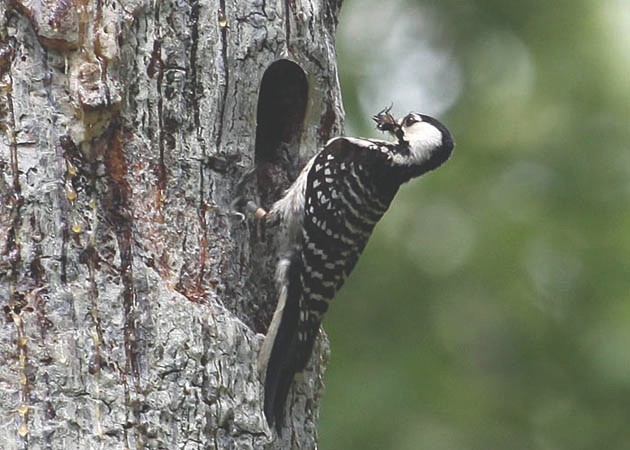
Red-cockaded Woodpecker (Picoides borealis)
The red-cockaded woodpecker is a non-migratory, medium-sized woodpecker, about 7 to 9 inches in length, with a very sharp black-and-white pattern. It has a black cap and nape encircling large white cheek patches, and black-and-white barring on its back and wings. Though it is often hidden and can be difficult to see in the field, the male has a small red streak on either side of its head called a “cockade,” which is actually a ribbon or other colorful symbol usually worn on a hat. The woodpeckers live in family groups usually including a breeding pair and one to four helpers, which are usually sons from previous breeding seasons. They breed between April and June, and the breeding male and female both incubate the eggs and the entire family group cares for the young. The whole family often forages together, mostly eating insects and arthropods found under bark, though they may also eat fruit and seeds.
Endemic to the United States, the red-cockaded woodpecker is an extreme habitat specialist, preferring mature longleaf pine forests (80 years old or more) maintained by frequent fires. It nests only in live pines, often in trees infected by the red heart fungus which softens the wood and makes it easier for the birds to dig of cavities for nesting, which can take two years or more to finish! The red heart fungus also causes the tree to “bleed” a heavy flow of sap, which helps to keep predators like tree snakes away from the nest. The bird was once common in the southeastern U.S., but because of its habitat specificity and loss of breeding habitat caused by over-cutting and fire suppression it is now federally endangered. In the last century the species experienced major population declines and many colonies disappeared, and today there are possibly fewer than 10,000 individuals remaining.
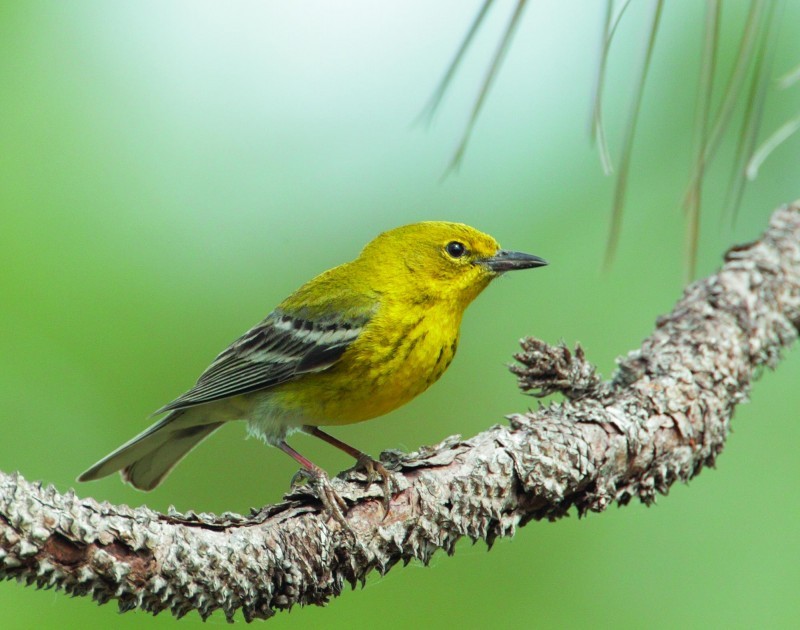
Pine Warbler (Setophaga pinus)
The pine warbler is a short-distance migrant found in the eastern United States, and unlike most warblers, the majority of these birds stay in the southeastern U.S. for the winter instead of leaving the country and flying further south. It is one of the earliest species to arrive in the spring, starting in February in the southern portion of its range, and it begins breeding in April. True to their name, pine warblers spend most of their time in pine trees, especially during the breeding season, so pine forests are especially critical habitat for these birds. However, across their range in the southeastern U.S., much of their native pine forests have been altered or destroyed by human development, logging, and fire suppression.
The pine warbler is a small, yellowish songbird (about 5.3 inches long) with a long tail, a white belly, an olive-gray back, and gray wings with two white wing bars. Adult males are more brightly colored, while females and young are duller and may be more grayish or brown. Pine warblers can be hard to find since they usually stay high in the trees, gleaning insects from foliage, but they can also be seen in the lower canopy and even on the ground foraging for seeds (mostly pine seeds!), fruits, and insects. Unlike most warblers, they can even be seen visiting bird feeders for seeds and suet. These birds move more slowly and leisurely through the trees than most other warblers, but males can still be aggressive. Sometimes the birds will even fight in mid-air, flying at each other and locking their bills together. Parents are also protective of their young and are known to perform broken-wing displays to distract predators and lure them away from the nest.
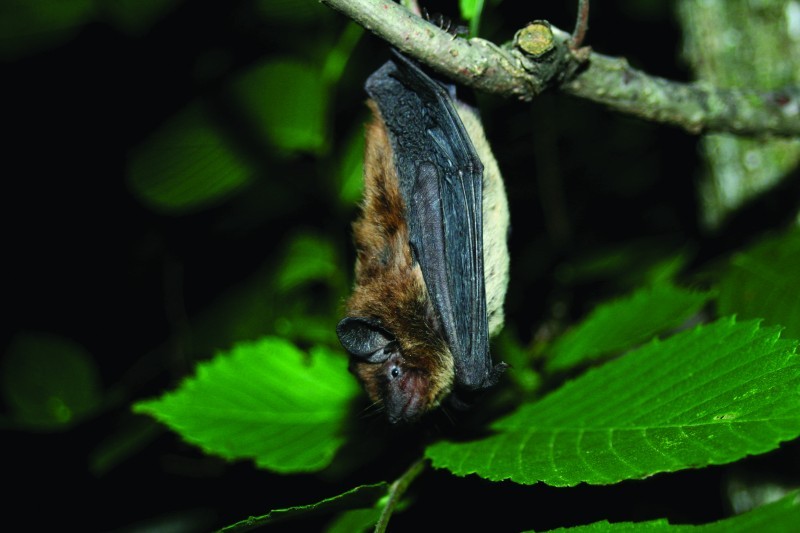
Evening Bat (Nycticeius humeralis)
The evening bat is small as far as bats go, weighing anywhere between 6 and 14 grams and measuring about 3 or 4 inches long, with a large wingspan that can be up to a foot in length! It has dark brown fur on its body, though its ears and wings are black. It is fairly common and has a stable population throughout most of its range, which stretches as far west as eastern Nebraska and east to North Carolina, and from the Great Lakes Basin southward to Texas and northern Mexico. Evening bats live primarily in forests, open areas, and river corridors, where they roost in the crevices of trees or behind loose bark. Due to habitat loss of old-growth timber this species has also started roosting in wooden buildings. Evening bats are insectivorous and forage while flying at night, using echolocation to locate their prey. They eat different types of beetles and other flying insects as they travel about clearings, over rivers, and around the edge of their forest habitat. One study estimated that a colony of about 300 bats could eat 6.3 million insects in just one summer! These bats provide an important ecosystem service to humans by controlling insect pests that could cause a lot of damage to farm crops and other important plants, so making sure they have good, sufficient habitat, like shortleaf pine forests, is beneficial to both us and them!
Evening bats live in colonies, but adult females actually separate from the males to form their own nursery colonies in hollow trees or buildings, where they usually give birth to 2 or 3 pups in late May or early June. After the young pups are about six weeks old and have finished weaning, the females will remain in the nursery colony where they were born while the males will leave the roost, and they will live for 2 to 5 years, being careful of predators such as snakes, raccoons, owls, and hawks. Like many bird species, the evening bat is thought to migrate southward in the fall, but not much is known about their winter habitat requirements or their seasonal migration.
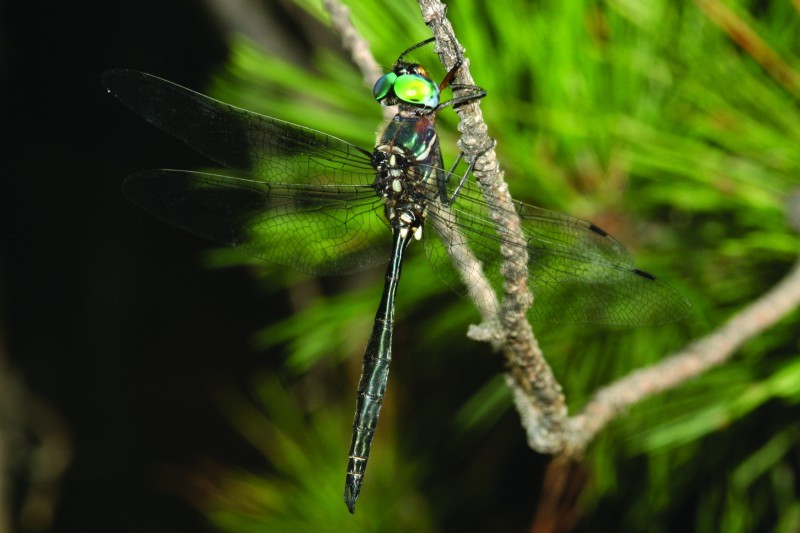
Ozark Emerald (Somatochlora ozarkensis)
The Ozark emerald is an uncommon dragonfly species that was first discovered in 1931 near Wilburton, Oklahoma and was officially described as a new species in 1933. Currently it has a “near-threatened” status, but in the past it was listed as rare and endangered. The Ozark emerald is a seasonal migrant species that looks very similar to a few other dragonfly species, including the Hine’s emerald dragonfly, the Mocha emerald, and clamp-tipped emerald, all of which have striking emerald green eyes. The Ozark emerald can be distinguished from its sister species by more prominent whitish stripes on the thorax, a distinctive terminal appendage, and bluer eyes. Its range is fairly restricted, as it has only been seen in two sites in Oklahoma, one in Missouri, and eight sites in Arkansas. Because it is uncommon and difficult to survey, little is known about its ecology, behavior, life history, habitat requirements, and population size, though it is thought to be stable currently. However, it is expected to decline in the future from habitat loss and damage caused by deforestation, human development, and pollution.
The Ozark emerald, like other dragon flies, spends much of its life as an aquatic nymph or larvae developing in wetland habitats. Its primary habitat is small freshwater streams in forested areas, such as shortleaf pine forests. This past year it was surprisingly observed in Osage County, Oklahoma, much further north in the state than had been previously seen. The larvae are hard to find and adults fly high in the air, making them difficult to survey. They can sometimes be seen in the late afternoon or at sundown capturing and consuming prey in the air as they fly. Because they have two pairs of wings that can beat independently, these dragonflies are very good at maneuvering through the air.
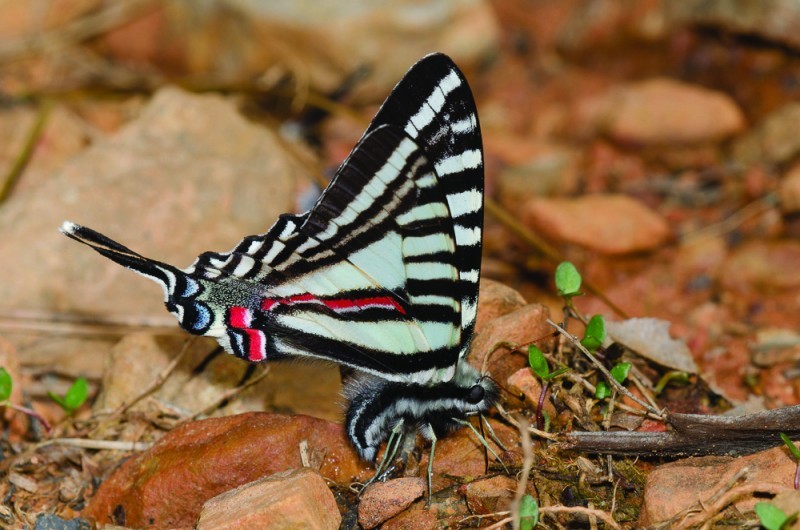
Zebra Swallowtail (Eurytides Marcellus)
The zebra swallowtail butterfly looks just like it might sound: its long, triangular wings are pale white with black stripes, like a zebra, and its hindwings have very long tails, like a swallow! It has a wingspan of 2.5 to 4 inches. The zebra swallowtail is one of the most beautiful swallowtail species and is the only native kite swallowtail in the United States. They live throughout the eastern half of the United States, including in Oklahoma, and inhabit moist, low woodlands such as pine forests for breeding, often close to rivers and swamps. The primary food source for these butterflies is nectar from flowers, which adults may find in open fields and brushy areas. They prefer the nectar from plants such as blueberry bushes, redbud trees, lilac, verbena, blackberry plants, and milkweed. Because zebra swallowtails have a shorter proboscis than some of their relatives, they usually feed from shorter, flatter flowers. Zebra swallowtails also differ from other swallowtails in that they don’t practice mimicry; while other swallowtails appear similar to species that taste bad to predators, helping to protect them against predation, zebra swallowtails don’t have this adaptation. However, if they are disturbed, such as by ants or spiders, they smear strongly smelling chemicals to try to ward off any threats.
Maintaining proper habitat is especially important for this species. This butterfly depends on its host plant, the paw paw, which is a small understory tree or shrub in moist, low woodlands in eastern North America. Female butterflies lay single green eggs on the underside of paw paw leaves, and then the caterpillars and pupae live and feed on these plants during development. Of course like other butterflies, the zebra swallowtail begins its life as a young larva and eventually metamorphoses into a beautiful adult butterfly! The young larva (the caterpillar) is dark with black, white, and yellow bands along its body, and as it gets older it becomes green with broader blue, yellow, and black bands. At this stage an individual is in danger of parasitoids, such as wasps. Once the caterpillar is fully grown it becomes a pupa, which can be green or brown in color and no longer looks like a caterpillar, and it has light lines across its body that makes it look like a leaf. It will use silk to attach itself to a plant leaf or stem and will then form a chrysalis to morph in a butterfly. Can you believe this entire process, maturing from an egg to an adult butterfly, only takes about a month? An adult butterfly’s lifespan is usually no more than six months.
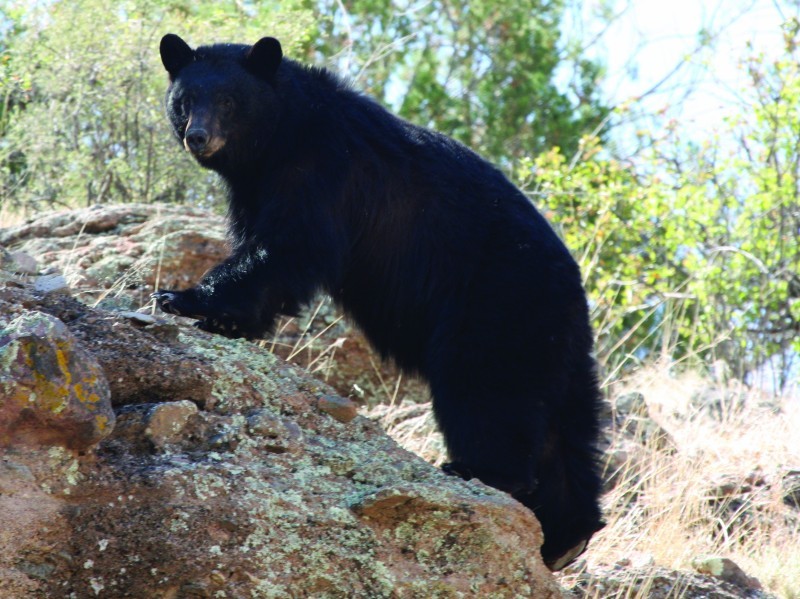
American Black Bear (Ursus americanus)
North America’s most common and familiar bear is the American black bear. It is a solitary animal whose home range stretches from Alaska and Canada through the United States and down into northern Mexico. Though they aren’t as widespread in the United States as they once were, their numbers are stable or increasing and can be found around the country, including the northeast, the Appalachian Mountains, the northern Midwest, the Rocky Mountains, and the west coast. They are good tree climbers and live mostly in forested areas with lots of trees and thick vegetation, including shortleaf pine forests, but they avoid open areas. However, they are able to live in many different places because they are opportunistic eaters and have a versatile diet. American black bears are omnivorous and their diet can include roots, plants, berries, insects, fish, deer, elk, and other sources of meat. If these bears are close to people they may even kill livestock, such as sheep, or eat pet food or people’s trash. This can be a big problem for the bears since people may view them as nuisances and then kill them.
The American black bear is a medium-sized bear, with adults being about three feet tall at shoulder-height and five to six feet long from nose to tail. Females weigh about 200 pounds and are much smaller than males, who can weigh up to 600 pounds! You would expect that black bears would always be black, but they’re actually very diverse in color and can have fur that is white, light brown, cinnamon-colored, dark brown, black, and everything in between. In the wild they can live for over twenty years, and females can have several litters of cubs over her lifetime. Here’s an interesting fact: these black bears mate in the early summer, but they have delayed implantation of the embryo until the fall when the mother retreats to her den for the winter. This allows her body to determine is she is physically prepared to carry cubs. If she is, she will give birth mid-winter and then nurse the cubs until the spring when they emerge from the den. Black bears spend the winters dormant in their dens but they are not “true” hibernators; they live off stored body fat and do not eat or drink at all, but they may wake up if disturbed. After birth, cubs usually stay with their mother through the next year’s winter, at which point they will separate and then the mother can breed again.
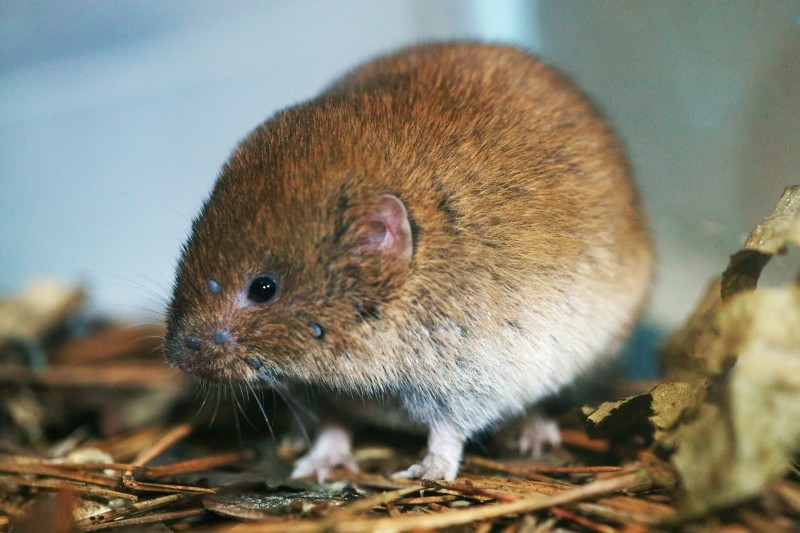
Woodland Vole (Microtus pinetorum)
The woodland vole is a small rodent that lives primarily in forests in the eastern half of the United States, going as far west as Oklahoma and Texas and as far north as southern Canada, and is fairly common throughout most of its range. Woodland voles are usually around 3.5 to 5 inches long and weigh between 15 and 35 grams, and they have short, soft brown fur on their back while their belly is whitish or silvery in color. The woodland vole is a burrowing animal that spends most of its time in shallow tunnels underground, and because of this they have small eyes, short ears and a short tail, and enlarged foreclaws for digging. They can live in a variety of habitats, but these voles prefer deciduous forests with a thick layer of litter and loose soil that is easier to dig around in. These tunnel systems are important not only because woodland voles spend most of their time in them, but also because they nest in the tunnels and are kept out of sight of predators. They nest either in the tunnel system or near the surface under logs, where females will have several litters each breeding season. In much of its range, this vole mates from early spring through late fall, but it actually breeds year-round in Oklahoma. Lucky for us! There are typically 3 to 7 young in a litter and they live only for about 3 months.
The tunnels are also important to hide from predators. Unfortunately for them, woodland voles are an important food source for many predators, including hawks, owls, foxes, raccoons, opossums, and skunks, but this makes them an important part of forest communities. Woodland voles are seemingly social creatures and are active at any time of the day or night. They are mostly herbivorous, eating grasses, sedges, roots, tubers, seeds, nuts, and fruits. In the fall they store food inside their burrows for the coming winter. Though they usually live in forests, they can also be found in orchards and plant nurseries, where they are considered pests because they cause damage to fruit trees and other plants by eating and destroying the roots underground.
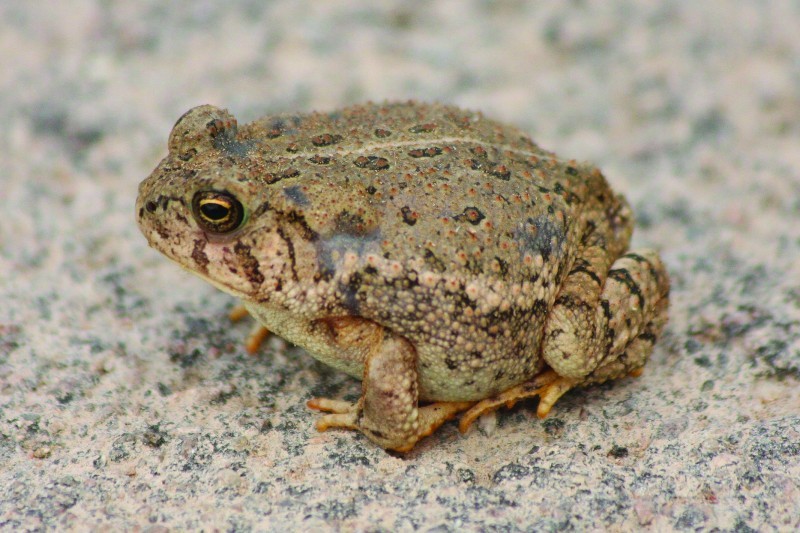
Woodhouse’s Toad (Anaxyrus woodhousii)
The Woodhouse’s Toad is the largest toad in Oklahoma and lives all around the state, but it can also be found in most of the central and southwestern U.S. and in parts of northern Mexico. According to the IUCN Red List, woodhouse’s toad is a species of least concern and is abundant and stable across its range. This toad is able to live in a variety of habitats, typically in wooded areas (like shortleaf pine forests) close to streams and other bodies of water, but it can also survive in grasslands, agricultural fields, and even in your neighborhood! An important habitat requirement for these animals is vegetation to hide in and good soil to burrow into during the day when they are usually inactive, since they are primarily nocturnal creatures. They also hide in the soil during the winter while they hibernate. Another important habitat requirement is a body of water with little-to-no current, which they need in order to reproduce. Woodhouse’s toads breed from March to August, usually after it rains. The females lay two long strings of up to 25,000 eggs in the water, and then these eggs will hatch into tadpoles, which are easy prey for turtles, fish, and other animals. Later when they metamorphose into adult toads they need to be careful of other predators, like snakes, skunks, raccoons, and herons, but at this stage they can defend themselves by secreting a white poison from the large parotoid gland behind each eye. This poison acts like a neurotoxin and causes the predator’s mouth and throat to swell. So, if you ever pick up one of these guys be sure to wash your hands afterward!
How do you know if what you’ve seen is a Woodhouse’s toad? They are usually between two and five inches long and have a white stripe down the middle of its grayish or brownish back. They often have scattered spots on their backs, as well, and their skin is bumpy. They have a thick head, a rounded snout, horizontal black pupils, and short back legs. They may be found away from water because they have tiny mucous glands that keep their skin moist. They eat mostly insects and you might even see them at night near your home, eating insects under a street light. If you see them around small pools of water in the spring and summer breeding season, you may even be able to tell if it’s a male or female; if you hear a toad calling, making sounds like the bleat of a sheep, you can be sure it’s a male, because females don’t make calls. Pretty interesting!